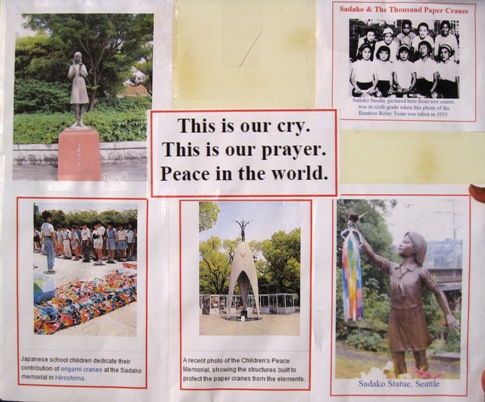People are gathering around the world this month to remember the 65th anniversary of the atomic bombing of Japan. The attacks by American planes on the cities of Hiroshima and Nagasaki effectively ended the Second World War. But they also launched the international campaign to ban nuclear weapons. One focus of this year's remembrance in Kalamazoo was teaching kids about the issue, as WMUK's Andy Robins reports:
Events commemorating the A-Bomb attacks on the two Japanese cities have been held in Kalamazoo since the mid-1980s. In more recent years they've been sponsored by the group Kalamazoo Non-violent Opponents of War, or KNOW. On Sunday (August 8), while adults gathered at the band shell in Bronson Park to hear about the politics of nuclear disarmament, their kids headed to small hill nearby:
[Johnson] "You guys who think 1954 was forever and ever ago, it was. It was the year before I was born."
A circle of kids formed around Lee Ann Johnson to hear her read the book Sadako and the Thousand Paper Cranes by Eleanor Coerr. It's based on the short life of a real girl, Sadako Sasaki, who was two years old when the atom bomb fell on Hiroshima:
[Johnson reading] "I remember the thunderbolt, Sadako whispered. There was the flash of a million suns. Then the heat prickled my eyes like needles. How could you possibly remember anything, Chizuko exclaimed, you were only a baby then. Well, I do, Sadako said stubbornly."
Sadako survived the bombing but became ill several years later when she was 12:
[Johnson reading] "Sadako heard the doctors say the word 'leukemia'. That was the sickness caused by the atom bomb. She put her hands over her ears not to hear anymore, but she couldn't make that word go away, could she?"
In the hospital, her friend Chizuko reminds her of the Japanese tradition that anyone who folds a thousand origami cranes will enjoy a long life. She hands one of the small paper birds to Sadako, who in turn tries to help a boy named Kenji, who also has leukemia:
[Johnson reading] "You can make paper cranes like I do so a miracle can happen. I know about the cranes, Kenji said quietly, but it's too late; even the gods can't help me now."
Kenji dies, and eventually Sadako does too, without reaching her goal of folding a thousand cranes:
[Johnson reading] "As Sadako grew weaker she wondered: did it hurt to die? Or was it like falling asleep? Would she live on a heavenly mountain or a star? She fumbled with a piece of paper and clumsily folded one more bird: 644. Her mother came in and felt her forehead. She gently took the paper away as Sadako closed her eyes. She heard her mother whisper, 'O flock of heavenly cranes, cover my child with your wings'."
After her death, Sadako's friends finished folding her cranes and later campaigned to have a statue of her placed in Hiroshima's Peace Park bearing the inscription:
[Raelynn Joyce] "This is our cry. This is our prayer: peace in the world."
Raelynn Joyce helped organize the telling of Sadako's story. She says it is a message of hope but also a warning about the cost of nuclear war. Kids at the Kalamazoo event folded their own origami birds in memory of Sadako Sasaki and others who died in Hiroshima and Nagasaki. Joyce brought her daughter to the observance in Bronson Park years ago, and now she, her daughter and her grand-daughter come each year:
"Hopefully the tradition of remembering; remembering what happened and committing to never again should we have that happen: those are the things we would like people to take out of this."
Kids also created floating Japanese paper lanterns that they launched on the reflecting pool in Bronson Park. One of the event's organizers - Tobi Hanna-Davies - says the lanterns are an ancient Buddhist way of honoring the dead. But she says they took on new meaning after the atomic bombs killed hundreds of thousands of people in the two Japanese cities:
"Children and elderly people and all kinds of civilians who were innocent and died: some immediately and others suffering for a long time. And so the idea of the lantern boats now is we honor those dead by remembering them and recommitting ourselves to prevent that from happening to anyone else."
For WMUK, I'm Andy Robins.

